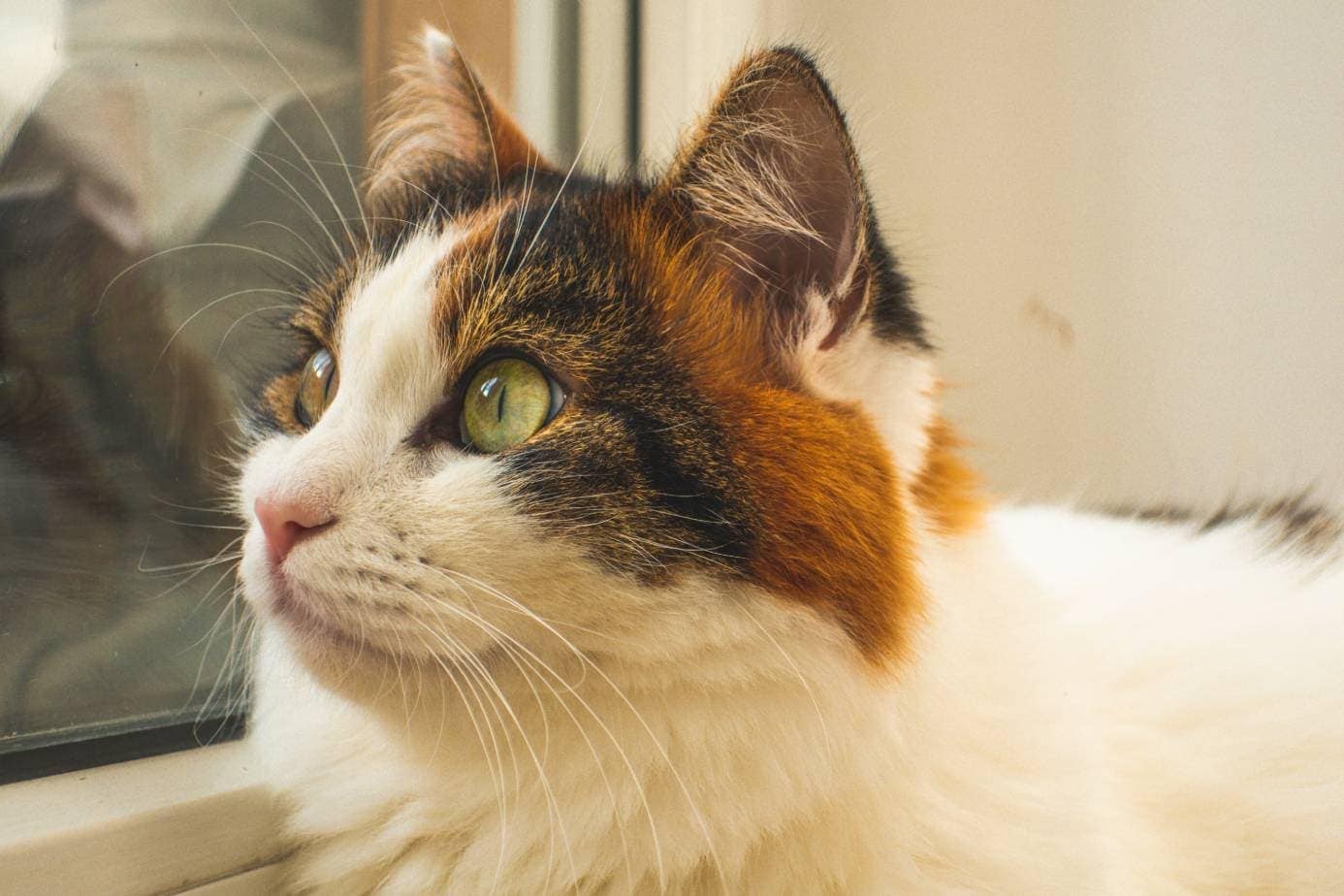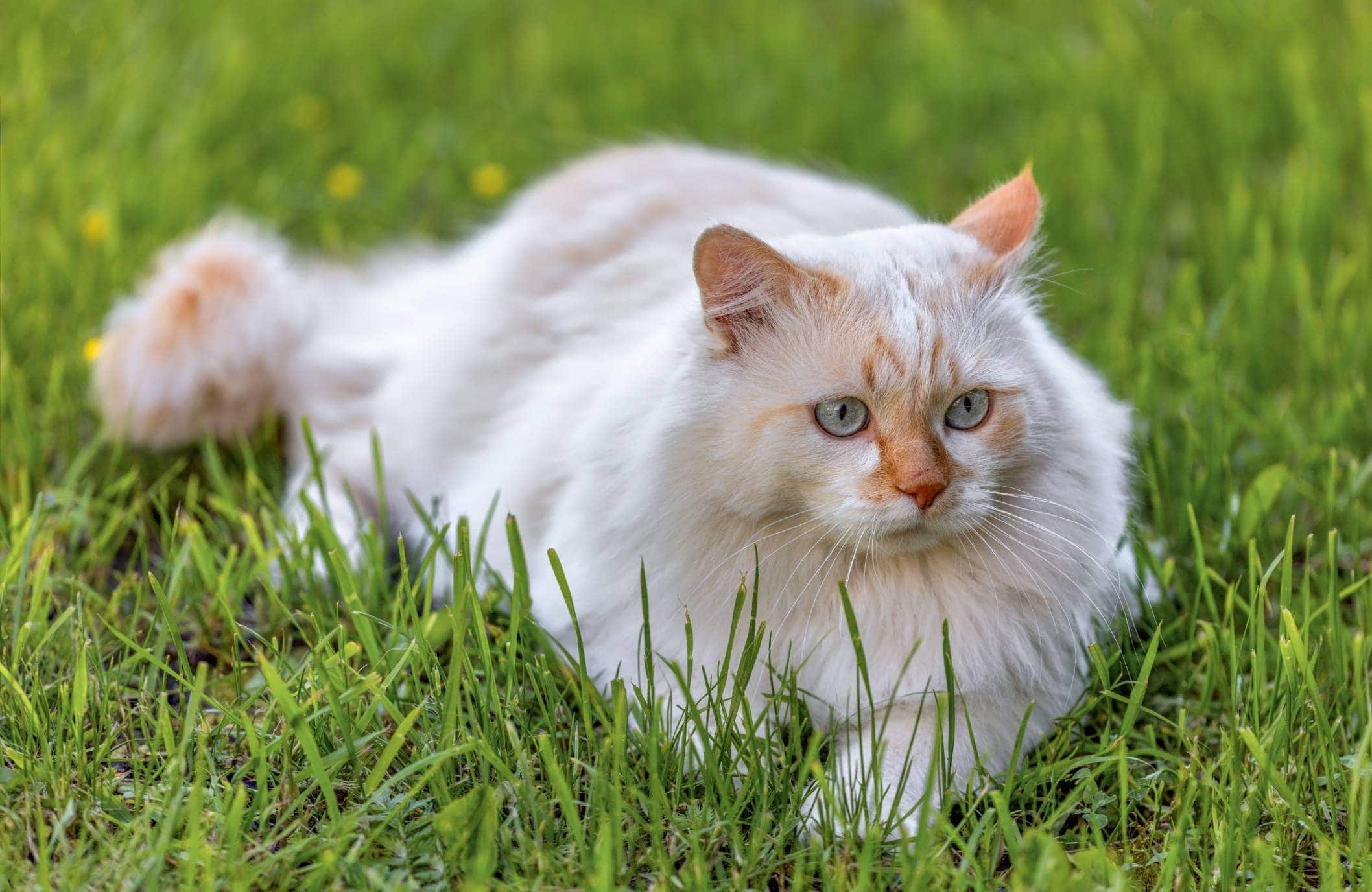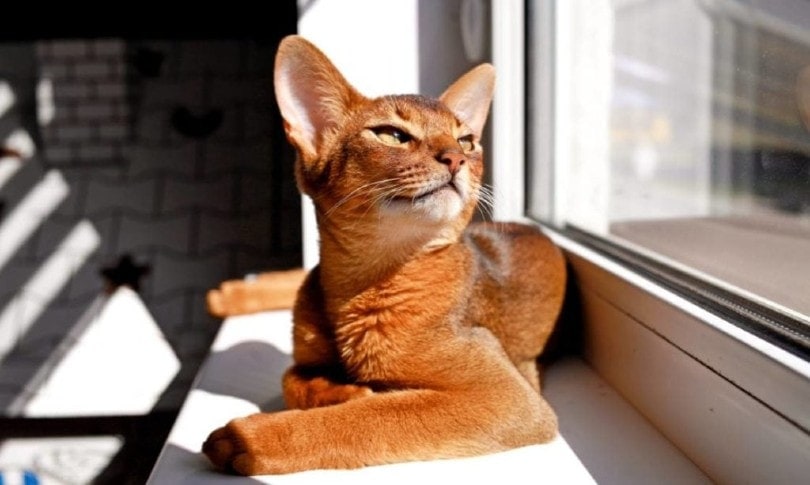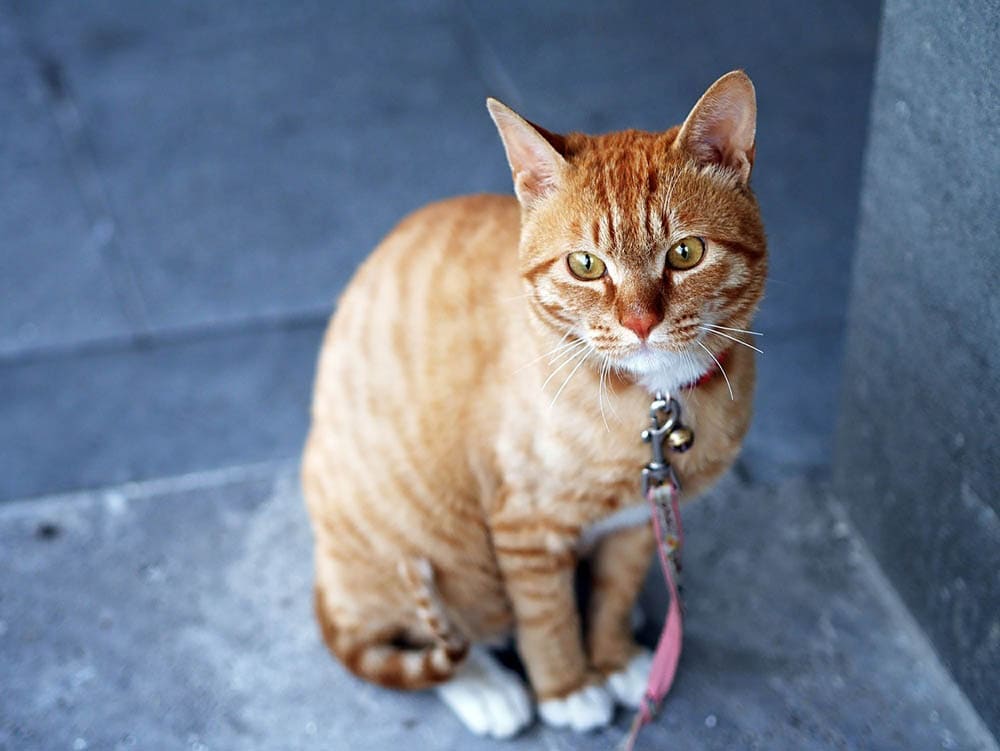Turkish Van Cat: Breed Info, Pictures, Temperament & Traits
Updated on

| Height: | 10-14 inches |
| Weight: | 7-20 pounds |
| Lifespan: | 12-17 years |
| Colors: | Piebald, Van pattern in any color |
| Suitable for: | Families looking for an attentive, energetic cat |
| Temperament: | Intelligent, energetic, people-oriented |
The Turkish Van is a natural breed of cat that developed in the mountainous regions of modern-day Turkey. Unlike other breeds of cats, they were not bred by people. Instead, they developed on their own in the wild.
They have two coat lengths that change with the season. This cat’s fur is noticeably longer and thicker in the winter, while it sheds into a shorter coat in the summer.
This breed is exceedingly rare, even within Turkey. It is tough to find them in the United States or other Western countries.
They are identifiable thanks to their unique Van pattern, which restricts their coloration to their head and tail. Otherwise, their whole body is white. While other cats can have this coloration as well, the Turkish Van only has this pattern.
It’s one of the things that sets them apart from other felines.
Turkish Van Kittens
Turkish Van kittens are pretty rare. There are only a few breeders in the United States, so you can expect to pay quite a bit for them.
There isn’t a huge reason to purchase a potential champion if you’re looking for a companion animal. Generally, pet-quality kittens are plentiful for those looking for a pet.
With that said, you should not cut corners by going to a pet store or backyard breeder. Often, these sources are cheaper – but there is a good reason for that. They put less money into their kittens, resulting in lower-quality cats altogether.
For instance, breeders often perform genetic testing on cats before they breed them. This testing prevents genetic conditions from being passed onto the kittens. As you can imagine, this results in healthier cats. Backyard breeders often don’t perform this testing, though.
If you want the highest quality kitten possible, purchasing from a breeder is essential.
 3 Little-Known Facts About the Turkish Van
3 Little-Known Facts About the Turkish Van
1. The Turkish Van was not developed by people.
People purposefully bred most cat breeds for one reason or another. However, the Turkish Van developed naturally. They are incredibly healthy for this reason. After all, they evolved to survive in the wild – which requires them to be extremely healthy and free from genetic conditions.
2. They have unique coloration.
These cats carry the piebald spotting gene. This gene only allows the cat’s pattern and coloration to appear on its head and tail. The rest of their body will be completely white. There is no getting around this coat pattern. It’s simply this breed’s genetics!
If a cat doesn’t have the Van coloration, it isn’t a Turkish Van.
3. This breed is exceptionally healthy.
Because this breed is ancient and naturally occurring, they are mostly free from genetic problems. When they were evolving, most cats with genetic problems didn’t make it to reproductive age. They developed in the wild. To survive, the cat had to be as healthy as possible.
The breed continues to be highly healthy today. They are still prone to a few common issues, though, like obesity.
 Temperament & Intelligence of the Turkish Van
Temperament & Intelligence of the Turkish Van
Turkish Van owners often describe them as being more similar to dogs than the stereotypical cat. These “dogs in cat form” are often extraordinarily devoted and people-oriented. They require more attention than your average feline.
If you’re looking for an affectionate cat, this breed may be precisely what you’re looking for. They are far more likely to deal with constant petting and attention.
However, this also means that they need more attention than your average house cat. They can’t simply be left to their own devices all day. They can quickly become lonely and bored, leading to destructive tendencies and poor behavior.
It isn’t odd for them to follow their family members from room to room – often begging for attention as they go.
This breed is also brilliant. They will get into things – it’s just in their nature. They play into the naughty, curious cat stereotype.
Many Turkish Vans like playing fetch with balls, toy mice, and similar toys. This behavior only adds to their dog-like temperament. They are more than intelligent enough to be trained.
You can efficiently train them to walk on a leash, sit, stay, and perform other standard commands.
While this feline is quite affectionate, they don’t like being held in most cases. The Turkish Van prefers to seek out affection on their terms, which is often quite a lot. They aren’t like the Ragdoll when it comes to being held, though.
Are These Cats Good for Families? 👪
They can be, as long as they are handled appropriately. The Turkish Van is not good at handling small children who don’t correctly handle cats. They won’t take kindly to children pulling on their ears, tail, or fur.
However, they can be comfortable around children as long as they are handled with care. This cat’s affectionate personality often makes them a good choice for families. They certainly offer enough feline energy to go around.
Of course, socialization is vital. A Turkish Van that is not taken around children at a young age can be fearful of them. If you were a tiny cat and saw a toddler for the first time, you would probably be a bit scared too!
Due to their intelligence, they remember when they aren’t treated appropriately. If a child hurts them, they may hold a grudge against children for years to come.
Therefore, interactions must always be supervised until the children show they know how to interact with a cat.
Does This Breed Get Along with Other Pets?
The Turkish Van doesn’t naturally get along with other cats, though they aren’t highly aggressive towards them either. It mostly depends on how they are socialized.
If they are brought up in a home with other cats, they are often accepting of them. These felines will never be incredibly social and affectionate with others of their kind, but that doesn’t mean they can’t live peacefully next to them.
Generally, they prefer human companions.
When socialized, these felines can also get along quite well with cat-friendly dogs. They don’t like to be chased – though we doubt any animal likes to be chased around. However, if the dog acts appropriately, a Turkish Van often won’t mind them.
Due to their wild nature, these felines have an extremely high prey drive. Therefore, they shouldn’t be left alone with anything that may be interpreted as prey. They are not cats to introduce to your guinea pigs.
https://www.instagram.com/p/CVPoCYMMmqB/?utm_source=ig_web_copy_link
Things to Know When Owning a Turkish Van:
Food & Diet Requirements 🐡
The Turkish Van does not require a particular diet. While they are a natural cat breed, that doesn’t necessarily mean they need a raw diet.
This breed usually does excellent on high-quality commercial cat food.
In the wild, this breed would essentially live off of mice and similar prey animals. You should aim to feed them commercial cat food that includes mainly animal products in captivity. The particular type of meat doesn’t matter unless your particular cat has sensitivities to a specific type of meat, like chicken, for example.
While the Turkish Van is usually entirely healthy, they are prone to obesity. It is essential not to overfeed them, though it is not uncommon for them to act hungry constantly. They will usually eat whenever food is offered, which can quickly lead to obesity.
Because they are already large cats, obesity can lead to significant problems. Their joints are often unable to hold up the extra weight, which leads to arthritis and similar issues. Diabetes and heart disease are both caused by obesity as well.
We do not recommend free-feeding these cats due to this predisposition.
Keep your Turkish Van lean to avoid health issues.
https://www.instagram.com/p/CLU4rRRM7dK/?utm_source=ig_web_copy_link
Exercise 🐈
Many owners describe these cats as particularly active. Given that they evolved in the wild, this makes sense. Most wild cats need to be much more active than domestic cats, after all.
Unlike other breeds, the Turkish Van is not content to sit around the house all day. They need regular physical activity – or you’re going to find them hanging from your curtains.
While people usually don’t think about their cat’s exercise needs, you need to with this breed. We highly recommend purchasing plenty of climbing structures to appease their exercise needs. Leash training for daily walks is also recommended.
Luckily, the Turkish Van is often not picky about how they exercise. Most of these felines will happily play fetch, chase a wand toy, climb cat condos, and go on walks. As long as they’re going in with their people, they typically don’t care what it is.
Training 🧶
The Turkish Van is intelligent and people-oriented. These traits go together to make them extremely easy to train. They are probably one of the easiest cats to train!
You can easily teach them to walk on a leash and perform most of the commands dogs learn. This cat breed may even outperform some dogs. They’re that good.
Their trainability is often why they are described as being very dog-like. They respond to training similarly to the way a dog would, especially those cats that are food-driven. You can train them just like you would train a canine.
Positive reinforcement training is paramount to their success. Most Turkish Vans are very food-driven. While this can be a problem when free-feeding, it is a boon during training. They pick up on what you want very quickly in most cases.
Their high companionship needs often encourage them to pay attention during training – unlike other cat breeds that tend to ignore their owners whenever they’re asked to do something.
There are plenty of books out there on training cats, as well as a few only programs. Sadly, there are usually no local, in-person classes on cat training. Typically, those are only for dogs. (And we do not recommend taking your cat to a dog training class – even if they do learn similarly).

Grooming ✂️
The Turkish Van has a strange coat. Technically, they are both long-haired and short-haired. It just depends on when you ask.
In the winter, their coats are quite long and dense. In the summer, they lose considerable amounts of fur and end up with a shorter coat. They are one of the only cat breeds to do this, though most do shed some of their coat in preparation for the warmer months.
Due to this unique pattern, these cats shed considerably more than most. If you can’t put up with a bit of cat hair, this is not the breed for you.
We highly recommend brushing your Turkish Van regularly, if only so they will accept grooming during these heavy-shedding periods. They likely won’t need to be brushed that much in the summer months, but winter is often a different story.
Brushing removes much of the excess fur and can also help keep their coat clean. Dirt and debris will often come out with the shedding hair. While cats are very good at keeping themselves clean, a bit of extra help never hurts.
You’ll need to brush them daily as they shed their winter coat. Throughout the rest of the year, weekly is often enough.
Their fur naturally resists matting, so at least you don’t have to worry about that!
- See Also: 11 Best Waterless Cat Shampoos
Health and Conditions 🏥
The Turkish Van is mainly free from genetic problems. They are incredibly healthy cats, as they evolved in the wild – not through human-led breeding programs.
Unlike other Turkish cats, they do not have any known problems with deafness. We currently don’t have any scientific evidence showing that these felines are more likely to become deaf than other cats.
For the most part, you’ll just be keeping an eye out for general cat problems. UTIs are common, but not necessarily more so than in other breeds.
Due to their larger size, they do develop slower than most other breeds. They often reach sexual maturity later, though this can vary substantially from individual to individual. You may want to speak with your vet about the correct time to spay or neuter your cat.
While we don’t have any scientific evidence to back up these claims, some say that waiting to spay or neuter the cat helps promote proper joint development. We highly recommend asking your vet their opinion, as they have intimate knowledge of your cat’s history.
As we briefly discussed earlier, this breed is prone to obesity. They are very food-driven and already quite large.
Just like with all breeds, obesity can hurt the cat’s hormones, joints, heart, and more. Obesity is entirely preventable – you need to feed your cat the correct amount.
- Obesity
- Urinary Tract Infection
- Arthritis
 Male vs. Female
Male vs. Female
There isn’t a significant difference between gender for these cats. Males can be significantly larger than females, reaching as much as 20 pounds. However, petite males exist as well.
Temperament isn’t affected by gender, either. Females are not more likely to be affectionate, and males aren’t more likely to be aggressive.
The only behavioral differences will be directly related to breeding. Males are more likely to mark, for instance. Females will go in heat, while males won’t. However, males will react to the smell of female cats in heat.
There are many misconceptions about gender-driven behaviors, but many of these are myths. Studies have found that there is not any significant difference between genders.

Conclusion
The Turkish Van is a rare breed that originates from Turkey. Unlike other breeds, they developed naturally in the wild – not through breeding programs. Therefore, they tend to be rather practical felines.
They are very people-oriented, which makes them suitable for those looking for a social cat. Turkish Vans are pretty adaptable to different households. They can be good with children and dogs, as long as they are socialized from a young age.
Due to their history, the Turkish Van is exceptionally healthy. They are not prone to any genetic conditions that we know of. However, because they are scarce, it could be that we just haven’t discovered their predispositions yet.
Only a handful of these cats are born in the United States each year. If you’re looking to adopt one, you’ll likely have to travel a decent distance and sit on a waiting list for a while. They also aren’t cheap, running at about $1,000 for a quality kitten.
However, if you have your heart set on them, they can make very good companion animals.
Featured Image Credit: Daryakor, Shutterstock

 Temperament & Intelligence of the Turkish Van
Temperament & Intelligence of the Turkish Van








